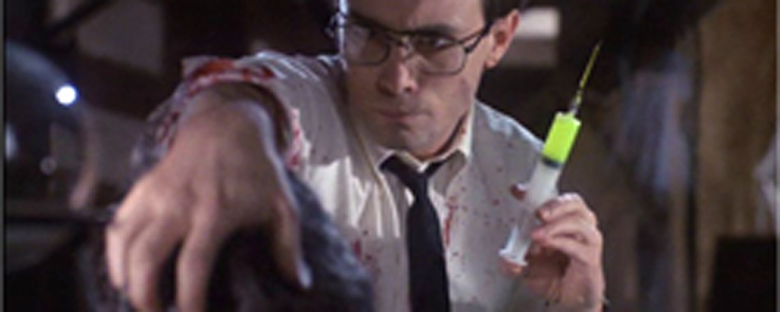Reviews
Stuart Gordon
USA, 1985
Credits
Review by Leo Goldsmith
Posted on 25 October 2005
Source Elite Entertainment DVD
Related articles
Features: 31 Days of Horror
Reviews: Frankenstein
Reviews: Bride of Frankenstein
Reviews: The Curse of Frankenstein
Reviews: Flesh for Frankenstein
Parts… I’ve never done whole… parts.
At the conclusion of Flesh for Frankenstein, the enraged Monster kills his creator, the perverse Baron Frankenstein, by first chopping off his hand and then skewering and removing his gall bladder. Disgusted with himself and wanting nothing more than death, the Monster then tears himself apart, dissecting the repulsive collagework of his creator.
If Flesh’s variation on the Frankenstein tale is its fragmentation of both creator and creature, Stuart Gordon’s Re-Animator goes a couple of steps further. Again there is a fundamental breakdown of the distinctions between mad scientist and monster, and again we see the dissection of these characters’ bodies. But here the parts themselves take on lives of their own, physically separate, but mystically linked to the original whole.
But let’s back up a bit. The year is 1984, and at a medical facility in California, the heart of a young female baboon is placed in the body of a young patient known only as Baby Fae. The transplant holds for twenty-one days, at which point the infant’s body finally rejects the foreign tissue and Baby Fae dies. Almost exactly one year later, Stuart Gordon’s film Re-Animator is released on a modest 185 screens in the United States, grossing just over a half a million dollars in its opening weekend.
Binding these two events together may seem like an unnecessary bit of pseudohistorical acrobatics, but the proximity of these two events suggests some illuminating connections. Gordon’s film, like all reanimation films, concerns the persistent revivification of dead bodies in an obsessive search for a reliable means of conquering death. To this end, Herbert West and his college roommate, Dan Cain, insist on injecting (and re-injecting) cadavers of various kinds with West’s fluorescent re-agent in spite of consistently disastrous and gory results. The horror of these little experiments (which invariably produce angry zombies that drool bloody ooze and kill people) plays upon our collective fears of transplants and organ donorship, posing unsettling answers to the question of what happens to our bodies after we die and the mad scientists get hold of us. This links the reanimation film to that distinct subgenre of transplant horror, which includes such films as The Hands of Orlac, Body Parts, and The Eye, films in which the past lives of donated body parts return to haunt their present owners.
If both the transplant horror film and the Frankenstein film plague us with fears about being a composite, collage body, Re-Animator exploits our fears of segmentation, of being many fragments of a body living independently. West begins with some simple experiments in bringing the dead back to life, but his scientific curiosity also leads him to do the same for “whole parts.” Thus, a severed head and its companion body are two separate, but metaphysically linked entities, and an arm and a small intestine can have violent wills of their own. And to muddle the mixture even further, Re-Animator poses not one, but two hare-brained theories of mad science. Parallel with West’s studies in reanimation is the work of the malevolent Dr. Carl Hill, whose laser lobotomies can be used to control the human will. Once Hill combines his laser drill with West’s re-agent, he has at his disposal an army of angry corpses (and their respective bits and pieces), all networked to the evil genius of his own Mabuse-like severed head.
Like all great Frankenstein variations (and perhaps all great horror films, in general), Re-Animator achieves its particular form of evil genius through an inspired hybridization of genres. If the Frankenstein story is yoked with German Expressionism in Whale’s adaptation, with the blaxploitation mode in Blackenstein, and with Italian horror and the Warholian avant-garde in Flesh for Frankenstein, Re-Animator weds the story with the gory teen horror films and nerd comedies characteristic of the 1980s. Boobs and gore inject the reanimation narrative with their own distinctive flavors, as Gordon transforms Whale’s expressionistic watchtower laboratory into a creepy suburban basement.
But strangely, in spite of these variations and hybridizations, all of this persistent resuscitation of the Frankenstein story seems fittingly to return it to its origins. In Herbert West, Gordon resuscitates Shelley’s portrayal of Dr. Frankenstein as an over-zealous college student, and in the character(s) of Dr. Hill, Re-Animator completes the transition of the Frankenstein-figure from mad scientist to monster and back.
Twenty years later, in 2005, these anxieties about the fragmentation and reanimation of our bodies are still firmly implanted. Only two months ago, British scientist announced the creation of a “miracle mouse” that can regenerate damaged organs and severed limbs. For now, we can only dream of the perverse implications such a self-reanimating body may have for contemporary horror. In the meantime, let’s sit back and watch for the first unpleasant signs of the Monster’s revival.
As Herbert West says, “Birth is always painful.” Re-birth doubly so.
We don’t do comments anymore, but you may contact us here or find us on Twitter or Facebook.



